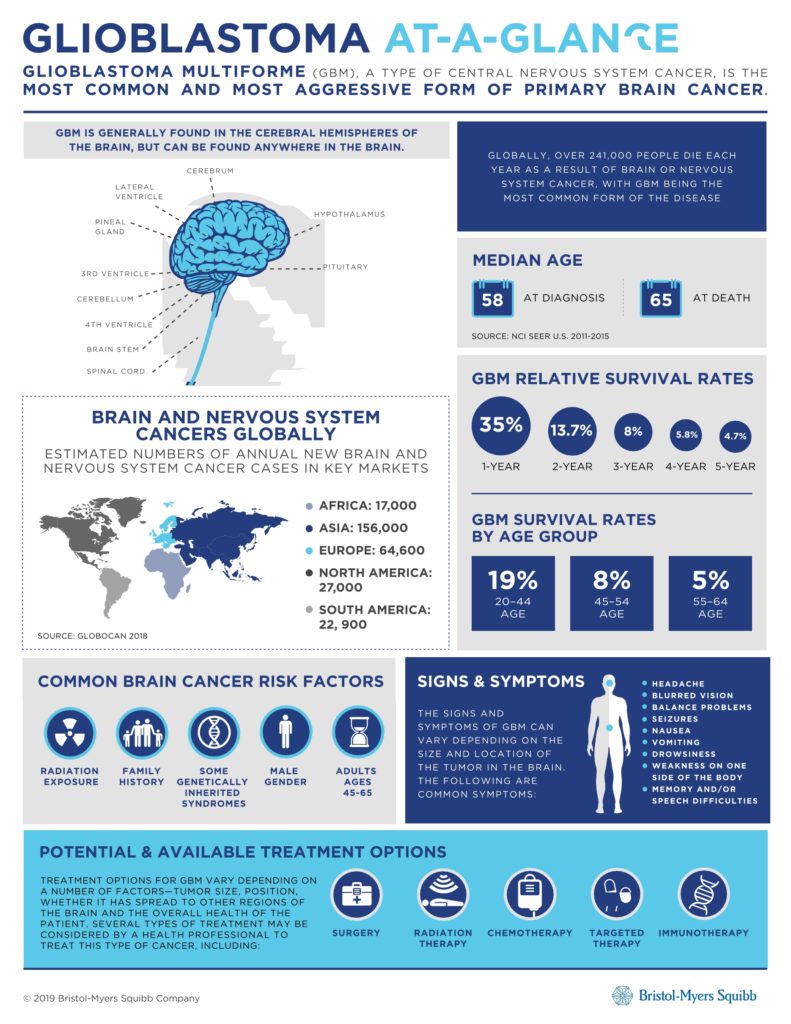GLIOBLASTOMA MULTIFORME (GBM), A TYPE OF CENTRAL NERVOUS SYSTEM CANCER, IS THE MOST COMMON AND MOST AGGRESSIVE FORM OF PRIMARY BRAIN CANCER, ACCOUNTING FOR 54% OF NEW GLIOMAS AND 45% OF PRIMARY MALIGNANT TUMORS.
189 000 cases die of brain cancer annually. USA is a hot spot for this disease with annual incidence rate of 13,200 cases. Many of the prominent political characters such as John McCain, Ted Kennedy and Beau Biden were the targets of this deadly disease.
5 year survival is less than 4 percent and even less in older patients. (1.7 percent survival at age 65 and more)
Historically radical resection was offered to these patients. There was no outcome benefit. Patients died in the same amount of time as if they had not gone through radical resections. The cause of death of quick recurrence in other areas of brain. It took scientists a long time to discover the fact that the tumor has already disseminated to the entire brain long before it is diagnosed at one spot!
“Removing all the visible tumor does not cure this cancer — ever,” said Dr. Mark Gilbert of the National Cancer Institute. Years ago, surgeons removed the entire half of the brain that glioblastoma was in. Even that “did not markedly increase survival,” he said: Patients still died because malignant cells had already invaded the rest of the brain.
Only 30 percent of these tumors are responsive to first-line chemotherapy, temozolomide. The ones who do respond only live 3 additional months compared to untreated. The tumor readily becomes resistant, due to mechanisms involved with cancer stem cells and EMT transition.
With all technologies developed in recent years, including techniques such as targeted drugs or immune therapies, vaccines, leading edge radiation, etc…,
The average cost of care for a refractory patient to live 12 months is 780 thousand dollars by one drug alone and the cost of hospitalizations and disability adds to the mix.
Despite all efforts to treat this disease, the complex cancer cell biology has defeated the man scientific skills and expertise. The Glioblastoma cells are able to move quickly, transit to a form of mobile cells (mesenchymal) and disseminate all through the brain making it impossible to effectively treat one area where the tumor is seen.
MTET effectively reduces the ability of glioblastoma cells to migrate and disseminate. It kills them directly and it targets the Glioblastoma stem cells. In different invivo models, epigenetic therapies have been able to drastically shrink the tumor where the chemotherapy has not been effective or had much less efficacy. Also epigenetic therapies are considered main stay of secondary prevention to reduce the risk of recurrence in this disease.
At this time CRLFoundation.org is working to sponsor and further assist in implementing an epigenetic therapy (MTET therapy) as part of a clinical study to refractory glioblastoma and is aiming at fully cover the cost of such trial estimated at 8 million dollars.

Image Credit: Bristol-Myers Squibb Company
http://pharmrev.aspetjournals.org/content/70/3/412
https://www.bms.com/assets/bms/us/en-us/pdf/Disease-State-Info/GLIOBLASTOMA-BY-THE-NUMBERS.pdf
https://www.medscape.com/viewarticle/846053
FDA Letter
